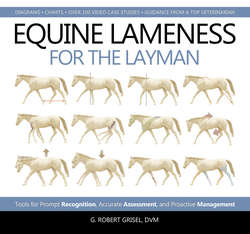Читать книгу Equine Lameness for the Layman - G. Robert Grisel DVM - Страница 35
На сайте Литреса книга снята с продажи.
3 The Definition of Lameness
ОглавлениеLameness can be defined as any alteration of the horse’s normal gait. A lame horse alters the way it moves to avoid torsion around painful joint(s) and to center ground reaction forces. A bruised foot, for example, will prompt the horse to change the way it moves its head, body, and limbs. These changes reflect the horse’s attempt to adjust the location and intensity of peak vertical forces experienced by the affected limb. This sounds logical, but what does this mean from a visual standpoint?
Perhaps it would be easier to start by defining soundness. For the purpose of this book, we will define soundness as regular and symmetric movement of the horse (VL 3a). Lameness, therefore, could be counter-described as irregular or asymmetric movement. Any visible difference in movement between the horse’s right and left sides would signify lameness. We generally think of lameness involving the limbs, but horses exhibiting irregular movement of the head, neck, or body (which comprise the median anatomy) would also be labeled as unsound based on this interpretation (VL 3b).
VL 3a Scan/Click to view video. www.getsound.com/tutorials/3a
VL 3b Scan/Click to view video. www.getsound.com/tutorials/3b
The lame horse alters its gait to avoid pain, accommodate some biomechanical restriction in movement, and/or maintain balance.
Depending on the degree of asymmetric movement, lameness might be easier or more difficult to discern with the naked eye. Veterinary studies suggest that, on average, the human eye requires approximately 25% asymmetry in movement in order to detect lameness.6 As we’ll learn, however, knowing where to look, when to look, and what to look for can dramatically enhance our ability to detect even slight variations in movement.
The reality is that every horse is probably lame to some degree; only those displaying enough abnormality to be perceived by the observer’s eye will receive further attention. Put more simply, our ability to distinguish abnormal movement from normal movement is primarily what separates unsound horses from sound horses, respectively.
